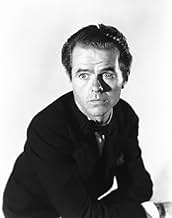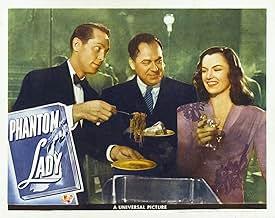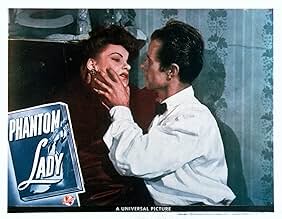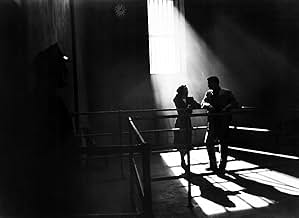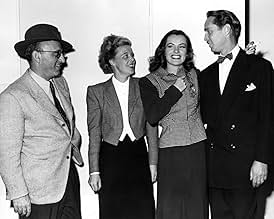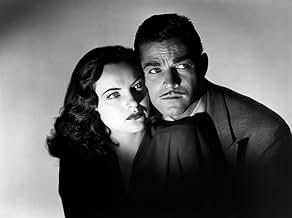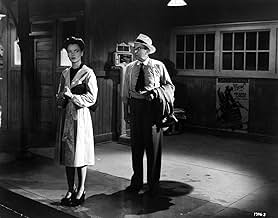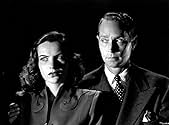IMDb रेटिंग
7.2/10
6.2 हज़ार
आपकी रेटिंग
अपनी भाषा में प्लॉट जोड़ेंA devoted secretary risks her life to try to find the elusive woman who may prove her boss didn't murder his selfish wife.A devoted secretary risks her life to try to find the elusive woman who may prove her boss didn't murder his selfish wife.A devoted secretary risks her life to try to find the elusive woman who may prove her boss didn't murder his selfish wife.
- निर्देशक
- लेखक
- स्टार
Aurora Miranda
- Estela Monteiro
- (as Aurora)
Harry Adams
- Courtroom Spectator
- (बिना क्रेडिट के)
Robert Bain
- Guitarist
- (बिना क्रेडिट के)
Joan Bayley
- Dancer
- (बिना क्रेडिट के)
Brandon Beach
- Theatre Party Guest
- (बिना क्रेडिट के)
Brooks Benedict
- Theatre Party Guest
- (बिना क्रेडिट के)
फ़ीचर्ड समीक्षाएं
I found this film noir to be odd in that the beginning and the end were both lousy but the middle part was excellent. The "lousy" parts are such because they drag on and are simply boring when they don't have to be. The immediate opening scenes are fine, showing an innocent man, "Scott Henderson" (Alan Curtis) being charged and found guilty of a murder he didn't commit....but then almost nothing happens for the next 20 minutes.
Then comes the good part when Henderson's secretary "Carol 'Kansas' Richmond" (Ella Raines) gets involved, taking it upon herself to find the missing woman who could prove that her boss was innocent. During her pursuit we meet a couple of very interesting characters and we see some outstanding film-noir photography.
The most interesting character, "Cliff," was played by film noir regular Elisha Cook Jr. He has one scene in which he takes Raines to a local warehouse-type room where his jazz band is practicing. Cook then shows off with this drum playing and it is so frenetic, so bizarre that it is almost shocking to watch. You have to see it, to appreciate it. It's a small, insignificant scene but very memorable. A few other minor characters are a bit strange, too.
Thomas Gomez plays a cop ("Inspector Burgess") who winds up helping Raines a bit, and he's good to watch, too.In the end, Raines discovers what's up and is in peril herself. That scene has suspense but is too drawn out. It's like, "okay, already.....let's go on with it!"
Then comes the good part when Henderson's secretary "Carol 'Kansas' Richmond" (Ella Raines) gets involved, taking it upon herself to find the missing woman who could prove that her boss was innocent. During her pursuit we meet a couple of very interesting characters and we see some outstanding film-noir photography.
The most interesting character, "Cliff," was played by film noir regular Elisha Cook Jr. He has one scene in which he takes Raines to a local warehouse-type room where his jazz band is practicing. Cook then shows off with this drum playing and it is so frenetic, so bizarre that it is almost shocking to watch. You have to see it, to appreciate it. It's a small, insignificant scene but very memorable. A few other minor characters are a bit strange, too.
Thomas Gomez plays a cop ("Inspector Burgess") who winds up helping Raines a bit, and he's good to watch, too.In the end, Raines discovers what's up and is in peril herself. That scene has suspense but is too drawn out. It's like, "okay, already.....let's go on with it!"
Film students and fans of film noir always hear about PHANTOM LADY and now that I've seen it I'm inclined to report that it's overrated. Though the premise is initially intriguing, it quickly accumulates so many plot holes that you instantly figure out who the murderer is. But this is an exercise in style, not content. Director Robert Siodmak saved the film by giving visual distinction to a poor script.
His training in the German Expressionist style makes for very striking images thoughout despite the low budget: dramatic contrasts between light and dark with simple, strong lighting effects never fail to provide interest and tension. And he goes a long way in suggesting the ethnic and racial mix of New York City in 1944 by his offbeat choice of extras and supporting players, most of whom are not the types you see in movies of the time. And the set of sculptor Franchot Tone's apartment complete with furniture and busts would be the envy of many a Soho or Tribeca resident in 2004.
In the lead, Ella Raines looks rather like a poor man's Gene Tierney. She is attractive and likable and you have no trouble maintaining interest in her, but she doesn't have much acting range, at least at this point in her career. Franchot Tone does a very professional job in an impossibly sketchy and ludicrous part, and Thomas Gomez is okay as the detective. As the wronged man, Alan Curtis provides his own visual interest via a strong jaw and broad shoulders, and an occasional hint of surliness makes his character more interesting.
But as others have indicated here, the single most surprising and effective scene is one where horny drummer Elisha Cook, Jr. takes Ella Raines to an after hours dive to show her what he's made of. Equating jazz and especially drumming with hot sex, Siodmak cross cuts between Cook's orgasmic frenzy at the drums (complete with a closeup insert of his crotch) with Ella seemingly transported as well, giving him the come-on, urging him to climax. It's the most overtly sexual scene I've ever seen in a '40s film and it's one you shouldn't miss.
His training in the German Expressionist style makes for very striking images thoughout despite the low budget: dramatic contrasts between light and dark with simple, strong lighting effects never fail to provide interest and tension. And he goes a long way in suggesting the ethnic and racial mix of New York City in 1944 by his offbeat choice of extras and supporting players, most of whom are not the types you see in movies of the time. And the set of sculptor Franchot Tone's apartment complete with furniture and busts would be the envy of many a Soho or Tribeca resident in 2004.
In the lead, Ella Raines looks rather like a poor man's Gene Tierney. She is attractive and likable and you have no trouble maintaining interest in her, but she doesn't have much acting range, at least at this point in her career. Franchot Tone does a very professional job in an impossibly sketchy and ludicrous part, and Thomas Gomez is okay as the detective. As the wronged man, Alan Curtis provides his own visual interest via a strong jaw and broad shoulders, and an occasional hint of surliness makes his character more interesting.
But as others have indicated here, the single most surprising and effective scene is one where horny drummer Elisha Cook, Jr. takes Ella Raines to an after hours dive to show her what he's made of. Equating jazz and especially drumming with hot sex, Siodmak cross cuts between Cook's orgasmic frenzy at the drums (complete with a closeup insert of his crotch) with Ella seemingly transported as well, giving him the come-on, urging him to climax. It's the most overtly sexual scene I've ever seen in a '40s film and it's one you shouldn't miss.
Phantom Lady is quintessential Film Noir and a must-see for anyone who appreciates the genre. The film is not, nor does it aspire to be, a whodunit with an airtight plot, or a mystery-thriller that ends with an inconceivable twist as in the original novel. If that is what you want or expect, this is probably not your cup of tea. Although many great films considered part of the noir genre may include some of these elements, that's not what film noir is all about.
Film Noir is almost synonymous with Cornell Woolrich (William Irish), the author of the novel Phantom Lady. His novels and short stories are the source of an amazing number of screenplays and teleplays, including several noir and non-noir classics such as Hitchcock's Rear Window.
As a writer and persona, Woolrich was a uniquely noirish sort of guy. In fact, he wrote a series of six "Black" novels, all have been adapted to the screen or TV at least once, and some multiple times. Obviously, noir means black, and these black novels inspire great noir films.
Many Woolrich stories, Phantom Lady is one, revolve around impossible crimes. As sinister forces close in, his protagonists are powerless do anything but follow some diabolical labyrinth that defies understanding. No wonder his work is a perfect fit for film noir, which takes place in its own dark universe, where characters struggle against powerful and malevolent forces. Unfortunately, the nightmare scenarios created by Woolrich, enhanced by his own inimitable style of description, often seem to get lost in translation when brought to the silver screen. Although most of the films are very good, these adaptations tend to be very different from their literary source.
Not so with Phantom Lady – up to a point. Although details may vary, director Robert Siodmak cleverly and adroitly uses dazzling Expressionist visuals and quirky character performances to emulate the dreamlike quality of a Woolrich story. A good example is the incredible scene where Elisha Cook Jr. drums up the sexual overtones for Ella Raines.
Since our psychotic mastermind is revealed early on, there is no who-done-it mystery to distract the audience. The revelation allows a brilliant means of reworking the story into a tight and infinitely more interesting screenplay. Woolrich's original story follows a different approach, not confirming the killer until the end. Obviously, some treatments work better as a novel than a movie.
Often over-shadowed in the movies which he appears, this time Franchot Tone fits so perfectly into the role of Jack Marlow that we are captivated by his machinations, wondering where it will all end. All of the other characters are great and true to form as well. Raines is exceptionally strong in her portrayal of the somewhat naive love-struck secretary who won't give up.
True to a Woolrich novel, the genius of the film is in the telling of the story; more important than structure or even the ending. Although the outcome is the same, the ending is much different in the novel. Also, after the killer is revealed in the original story, there are 16 long pages, explaining every detail of every plot twist. Unfortunately, this approach is anticlimactic, and would never work as a film. Nevertheless, Siodmak is able to present a more convincing story with almost no explanation.
Any screen adaptation of a Woolrich story is always in jeopardy of being swallowed up by massive plot holes. After all, part of the charm of a Cornell Woolrich story is that you never really know if you dealing with reality, or trapped in a drug and alcohol induced nightmare.
In Phantom Lady, a character reveals, " I'd been blazing a reefer already before it happened, and you know what that does to you." Woolrich certainly did know, and much of his literature is obviously inspired by mind-bending experiences. If a screenwriter and director can artfully breach the massive plot chasms of an original Woolrich story, yet still preserve the beauty as in Phantom Lady, the film becomes a feast for any Film Noir fanatic.
Film Noir is almost synonymous with Cornell Woolrich (William Irish), the author of the novel Phantom Lady. His novels and short stories are the source of an amazing number of screenplays and teleplays, including several noir and non-noir classics such as Hitchcock's Rear Window.
As a writer and persona, Woolrich was a uniquely noirish sort of guy. In fact, he wrote a series of six "Black" novels, all have been adapted to the screen or TV at least once, and some multiple times. Obviously, noir means black, and these black novels inspire great noir films.
Many Woolrich stories, Phantom Lady is one, revolve around impossible crimes. As sinister forces close in, his protagonists are powerless do anything but follow some diabolical labyrinth that defies understanding. No wonder his work is a perfect fit for film noir, which takes place in its own dark universe, where characters struggle against powerful and malevolent forces. Unfortunately, the nightmare scenarios created by Woolrich, enhanced by his own inimitable style of description, often seem to get lost in translation when brought to the silver screen. Although most of the films are very good, these adaptations tend to be very different from their literary source.
Not so with Phantom Lady – up to a point. Although details may vary, director Robert Siodmak cleverly and adroitly uses dazzling Expressionist visuals and quirky character performances to emulate the dreamlike quality of a Woolrich story. A good example is the incredible scene where Elisha Cook Jr. drums up the sexual overtones for Ella Raines.
Since our psychotic mastermind is revealed early on, there is no who-done-it mystery to distract the audience. The revelation allows a brilliant means of reworking the story into a tight and infinitely more interesting screenplay. Woolrich's original story follows a different approach, not confirming the killer until the end. Obviously, some treatments work better as a novel than a movie.
Often over-shadowed in the movies which he appears, this time Franchot Tone fits so perfectly into the role of Jack Marlow that we are captivated by his machinations, wondering where it will all end. All of the other characters are great and true to form as well. Raines is exceptionally strong in her portrayal of the somewhat naive love-struck secretary who won't give up.
True to a Woolrich novel, the genius of the film is in the telling of the story; more important than structure or even the ending. Although the outcome is the same, the ending is much different in the novel. Also, after the killer is revealed in the original story, there are 16 long pages, explaining every detail of every plot twist. Unfortunately, this approach is anticlimactic, and would never work as a film. Nevertheless, Siodmak is able to present a more convincing story with almost no explanation.
Any screen adaptation of a Woolrich story is always in jeopardy of being swallowed up by massive plot holes. After all, part of the charm of a Cornell Woolrich story is that you never really know if you dealing with reality, or trapped in a drug and alcohol induced nightmare.
In Phantom Lady, a character reveals, " I'd been blazing a reefer already before it happened, and you know what that does to you." Woolrich certainly did know, and much of his literature is obviously inspired by mind-bending experiences. If a screenwriter and director can artfully breach the massive plot chasms of an original Woolrich story, yet still preserve the beauty as in Phantom Lady, the film becomes a feast for any Film Noir fanatic.
So how did the producers get that orgasmic release scene past the censors. Sure, Carol (Raines) and Cliff (Cook) are about ten feet apart as he pounds on the drums while she sways back and forth in total sync, their faces contorted in frenzied delight. There's no guesswork here. It's as close to the real thing as the decade gets, and a masterpiece of simulated ecstasy. I wonder what the set was like while filming this.
The movie's a tight little thriller, helmed by noir master Robert Siodmak. So who is it that's framing architect Henderson (Curtis) for his wife's murder. By golly, the lovelorn Carol is going to find out even if it leads her down every dark, scary street on the studio lot. And once she dons her cheap hep-cat outfit, that's just where she's headed. But it's that frenzied jazz scene with Cliff that steals the show. Everything after seems something of an anti-climax. However, be sure to catch that beautifully modulated scene where Carol plies the emotionally disturbed Ann (Helm) for access to the incriminating ladies' hat. It's poignantly done, especially by actress Helm.
No doubt, this is one of the noir highpoints of the period, with dark symbolism and atmospheric shadows aplenty. Also, Raines gives a winning performance as the unstoppable Carol, while Tone wisely refuses to go over the top as the psychopath. On the other hand, it's a good thing we don't see much of Curtis in both a badly written and dimly performed part. I'm guessing Siodmak cared little how that particularly conventional role came across. Anyway, for fans of 40's noir, this Universal programmer remains a must-see.
The movie's a tight little thriller, helmed by noir master Robert Siodmak. So who is it that's framing architect Henderson (Curtis) for his wife's murder. By golly, the lovelorn Carol is going to find out even if it leads her down every dark, scary street on the studio lot. And once she dons her cheap hep-cat outfit, that's just where she's headed. But it's that frenzied jazz scene with Cliff that steals the show. Everything after seems something of an anti-climax. However, be sure to catch that beautifully modulated scene where Carol plies the emotionally disturbed Ann (Helm) for access to the incriminating ladies' hat. It's poignantly done, especially by actress Helm.
No doubt, this is one of the noir highpoints of the period, with dark symbolism and atmospheric shadows aplenty. Also, Raines gives a winning performance as the unstoppable Carol, while Tone wisely refuses to go over the top as the psychopath. On the other hand, it's a good thing we don't see much of Curtis in both a badly written and dimly performed part. I'm guessing Siodmak cared little how that particularly conventional role came across. Anyway, for fans of 40's noir, this Universal programmer remains a must-see.
'Phantom Lady' (retitled in my country as 'Witness wanted') is a little gem for anyone who appreciates 1940s film noir. It need not feature any of the big stars (Bogart, Cagney, Laughton, Ladd etc.), because its strengths are its excellent b/w photography and an interesting story that doesn't rely on predictable clichés of the genre.
Scott Henderson (Alan Curtis) is arrested for the murder of his wife. He is completely innocent, since he spent the evening at a theater with an unknown woman he invited after he met her at a bar (yes, his marriage has seen better days). But when asked for an alibi, not only that 'phantom lady' has disappeared, also several witnesses deny to have seen him with her. Thus, he's thrown into jail, and only his secretary (Ella Raines) and inspector Burgess (Thomas Gomez) don't give up the investigation. When Marlow (Franchot Tone), an old friend of Henderson, offers his assistance, the investigation is taking up speed, but meanwhile another witness was murdered. How can they defend Henderson without witnesses?
What I liked especially about 'Phantom Lady' is that there is no actual hero. Henderson is giving up, sits in his prison cell all day and doesn't show any hope. It's almost like he wants to be imprisoned for something he didn't do. So it's really the secretary who becomes the central character, driving the search for the real murderer. Quite unusual for the times and well worth watching.
Scott Henderson (Alan Curtis) is arrested for the murder of his wife. He is completely innocent, since he spent the evening at a theater with an unknown woman he invited after he met her at a bar (yes, his marriage has seen better days). But when asked for an alibi, not only that 'phantom lady' has disappeared, also several witnesses deny to have seen him with her. Thus, he's thrown into jail, and only his secretary (Ella Raines) and inspector Burgess (Thomas Gomez) don't give up the investigation. When Marlow (Franchot Tone), an old friend of Henderson, offers his assistance, the investigation is taking up speed, but meanwhile another witness was murdered. How can they defend Henderson without witnesses?
What I liked especially about 'Phantom Lady' is that there is no actual hero. Henderson is giving up, sits in his prison cell all day and doesn't show any hope. It's almost like he wants to be imprisoned for something he didn't do. So it's really the secretary who becomes the central character, driving the search for the real murderer. Quite unusual for the times and well worth watching.
क्या आपको पता है
- ट्रिवियाThe elusive phantom lady being sought by Carol "Kansas" Richman (Ella Raines), is repeatedly referenced as "Miss Terry" (i.e., "mystery").
- गूफ़Cliff's (Elisha Cook Jr.) "drumming" at no time matches the drums on the soundtrack.
- भाव
Cliff: You and I are going to have fun tonight, Jeannie! You like jive?
Carol Richman: You bet! I'm a hep kitten!
- कनेक्शनFeatured in CSI: Crime Scene Investigation: A Night at the Movies (2003)
- साउंडट्रैकI'll Remember April
(uncredited)
Music by Gene de Paul
Lyrics by Patricia Johnston & Don Raye
[played during opening credits and throughout the movie]
टॉप पसंद
रेटिंग देने के लिए साइन-इन करें और वैयक्तिकृत सुझावों के लिए वॉचलिस्ट करें
- How long is Phantom Lady?Alexa द्वारा संचालित
विवरण
- चलने की अवधि1 घंटा 27 मिनट
- रंग
- पक्ष अनुपात
- 1.33 : 1
इस पेज में योगदान दें
किसी बदलाव का सुझाव दें या अनुपलब्ध कॉन्टेंट जोड़ें



